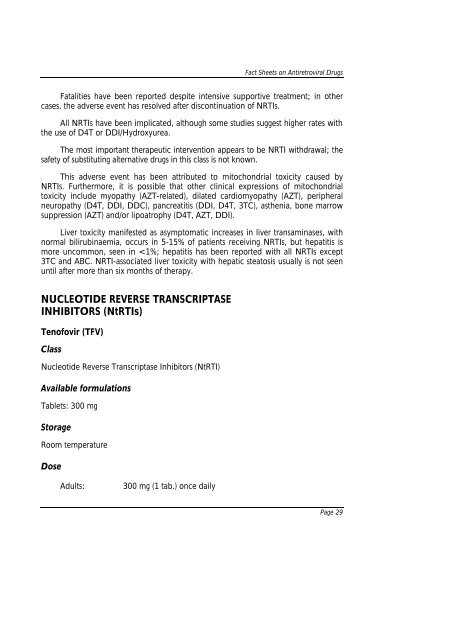Fact Sheets on Antiretroviral Drugs
Fact Sheets on Antiretroviral Drugs
Fact Sheets on Antiretroviral Drugs
You also want an ePaper? Increase the reach of your titles
YUMPU automatically turns print PDFs into web optimized ePapers that Google loves.
<str<strong>on</strong>g>Fact</str<strong>on</strong>g> <str<strong>on</strong>g>Sheets</str<strong>on</strong>g> <strong>on</strong> <strong>Antiretroviral</strong> <strong>Drugs</strong><br />
Fatalities have been reported despite intensive supportive treatment; in other<br />
cases, the adverse event has resolved after disc<strong>on</strong>tinuati<strong>on</strong> of NRTIs.<br />
All NRTIs have been implicated, although some studies suggest higher rates with<br />
the use of D4T or DDI/Hydroxyurea.<br />
The most important therapeutic interventi<strong>on</strong> appears to be NRTI withdrawal; the<br />
safety of substituting alternative drugs in this class is not known.<br />
This adverse event has been attributed to mitoch<strong>on</strong>drial toxicity caused by<br />
NRTIs. Furthermore, it is possible that other clinical expressi<strong>on</strong>s of mitoch<strong>on</strong>drial<br />
toxicity include myopathy (AZT-related), dilated cardiomyopathy (AZT), peripheral<br />
neuropathy (D4T, DDI, DDC), pancreatitis (DDI, D4T, 3TC), asthenia, b<strong>on</strong>e marrow<br />
suppressi<strong>on</strong> (AZT) and/or lipoatrophy (D4T, AZT, DDI).<br />
Liver toxicity manifested as asymptomatic increases in liver transaminases, with<br />
normal bilirubinaemia, occurs in 5-15% of patients receiving NRTIs, but hepatitis is<br />
more uncomm<strong>on</strong>, seen in









